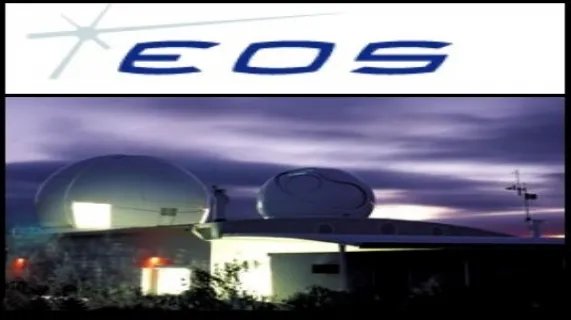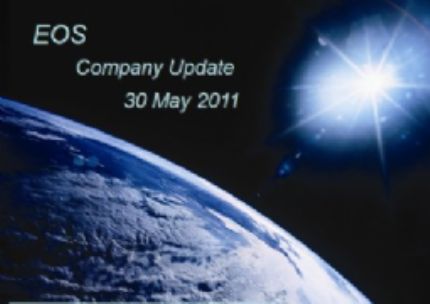
Electro Optic Systems (ASX:EOS) Welcomes A Closer US and Australia Space Partnership
Sydney, Nov 10, 2010 AEST (ABN Newswire) - Electro Optic Systems Holdings Limited ( ASX:EOS) (
ASX:EOS) ( PINK:EOPSF) welcomes the closer collaboration announced this week between Australia and the US in the area of space surveillance and space situation awareness, with specific focus on space debris tracking and mitigation.
PINK:EOPSF) welcomes the closer collaboration announced this week between Australia and the US in the area of space surveillance and space situation awareness, with specific focus on space debris tracking and mitigation.
The Australia-United States Ministerial Consultations [AUSMIN] for 2010 were held in Melbourne on 8 November, and were attended by US Secretary of State Hillary Clinton, US Secretary of Defence Robert Gates, Australian Foreign Minister Kevin Rudd and Australian Defence Minister Stephen Smith.
A joint communiqué issued after the meeting stated:
"Building upon a long history of defence space cooperation, Australia and the United States signed a Space Situational Awareness Partnership Statement of Principles, which should enable further close cooperation on space surveillance to the benefit of both countries."
"Australia and the United States shared a deep concern about the increasingly interdependent, congested, and contested nature of outer space and acknowledged that preventing behaviours that could result in mishaps, misperceptions or mistrust was a high priority."
The two governments also endorsed a Joint Statement on Space Security highlighting their shared views and resolve to cooperate with like-minded countries to ensure free and safe access to space.
Commenting after the AUSMIN, Defence Minister Stephen Smith said:
"We have made progress in two of the challenges of this century, newly emerging challenges both in cooperation in space surveillance and space situational awareness and also in the area of cyber attacks."
Under the partnership agreement the two countries plan joint activities that may include establishing ground-based radar and optical stations to track satellites and other orbital objects passing over the Asia-Pacific region. This will enable Australia to support the U.S. Space Surveillance Network in providing more accurate warning of potential collisions in space, according to AUSMIN fact sheets.
Space is becoming increasingly congested due to the debris from over 50 years of space activities.
Currently there are an estimated 500,000 pieces of space debris of 1 centimetre diameter or larger in orbit around the Earth. Even debris of 1 cm is capable of damaging or destroying satellites and space vehicles, and harming human spaceflight because of the high collision speeds involved, exceeding 6 km per second. The vast field of space debris generated in the past 50 years is now a real threat to the continued use of space by all countries.
Currently just over 16,000 objects are being tracked, ranging from large objects like the International Space Station and satellites, down to small pieces of debris of approximately 10 cm in diameter. New technology and sensors are required to monitor debris smaller than 10 cm, and finding and tracking 1 cm debris in space presents significant challenges, especially as the quantity of debris increases rapidly as size decreases.
EOS is a world leader in space tracking, and has developed and deployed space tracking systems capable of cost-effectively locating and accurately tracking space debris as small as 1 cm in size. This capability has been successfully demonstrated and tested under both US and Australian government-sponsored space programs.
Recently [19 July 2010] EOS announced that it had received Australian government grant funds of A$4.04 million to upgrade a space debris tracking site to automated operation by 2012. This upgrade is proceeding on schedule.
An effective space debris tracking capability would require a number of such tracking facilities and important initial sites for these facilities are in the US and Australia.
EOS already operates a space laser tracking facility in Western Australia, as well as in the ACT region.
EOS' Chief Executive Officer Dr Ben Greene said:
"Most advanced global economies are highly dependent on satellites in space for communication, navigation, entertainment, internet, resource management, global monitoring, weather forecasting and defence. These satellites represent a collective investment of more than A$600 billion.
"Space debris is a serious threat to this infrastructure and these applications, and EOS has been developing cost-effective debris solutions for more than a decade, based on its world-leading laser tracking capabilities.
"EOS expects to be fully operational with the world's first automated laser tracking site for space debris by 2012, and we look forward to supporting Australian government initiatives to address this global problem in collaboration with the US."
Contact
Ben Greene
Chief Executive Officer
Electro Optic Systems Holdings Limited
Ph: +61-414-365-658
www.eos-aus.com
John Palisi
Chief Finance Officer
Electro Optic Systems Holdings Limited
Ph: +61-403-252-685
| ||
|







